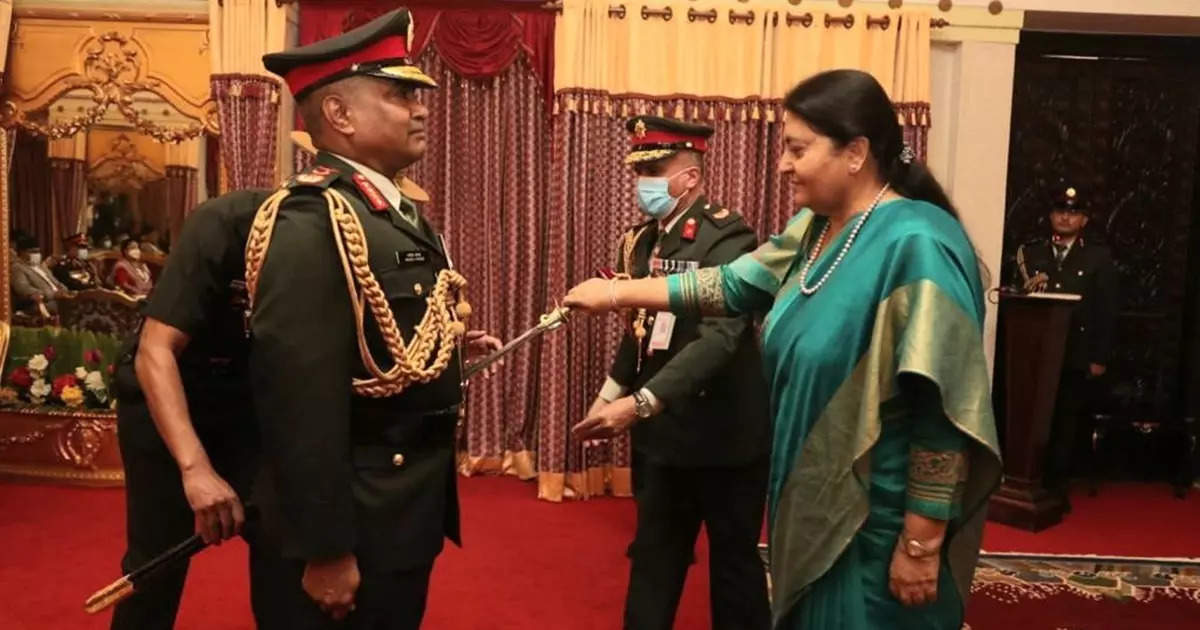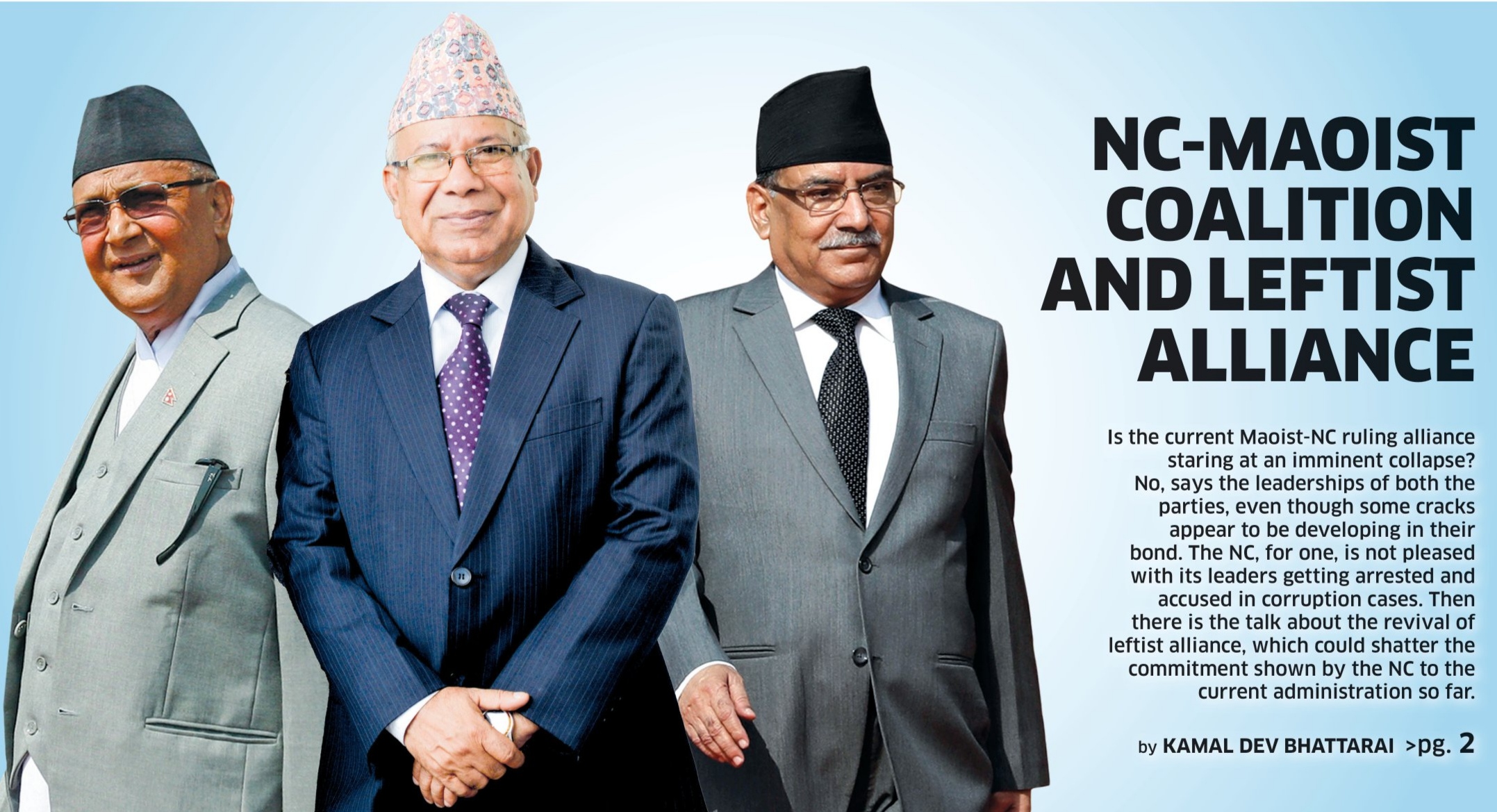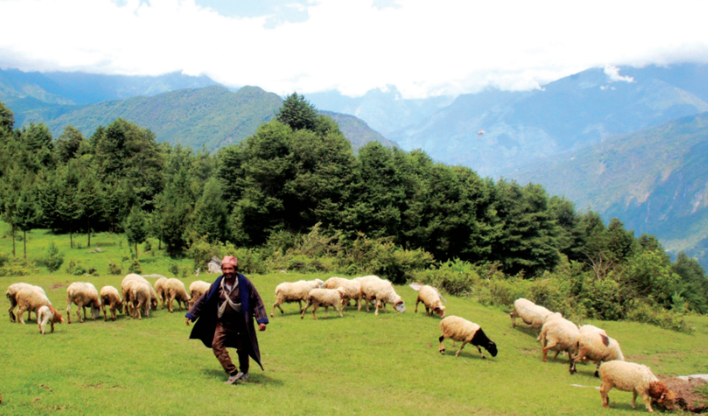Rudra Neupane: The brain behind Run Shoes success story
Rudra Neupane, 44, comes from a farming family background in Sindhupalchok. His village was at a remote part of the district, where there were no schools until the 1980s. Neupane went to school fairly late in his life and came to Kathmandu in 1994 for higher studies. In 1997, he was called back to his village to vote in the local elections, but he remained there for five years.
“I had gone home to vote but I stayed there after I was offered a teaching job in the high school that I attended as a child,” says Neupane. “Later on, I quit teaching and started working at the District Development Committee as a social mobilization officer.” He got married in 2001 with his wife, who was also a teacher. Neupane says his wife didn’t didn’t like the teaching field and wanted him to find another line of work. His work as a social mobilization officer, though a government job, was a temporary one, so he wanted to find a good stable employment.
“But finding a job was challenging back then,” Neupane says. “The difficulty in finding a decent job made me realize that I should rather start my own business and create jobs for others.” The couple decided to start a business but they had no promising entrepreneurial idea. They analyzed the market and consulted with friends and relatives. Neupane’s maternal uncles were already in the trade business, but it was not what he wanted.  “I was more inclined into agriculture-related business because of my farming background.” The agriculture-based business never panned out. The couple instead started Run Shoes Industries, a footwear company, in 2012. Neupane says the idea for the company came to him while working with footwear wholesalers to support his family in Kathmandu.
“I was more inclined into agriculture-related business because of my farming background.” The agriculture-based business never panned out. The couple instead started Run Shoes Industries, a footwear company, in 2012. Neupane says the idea for the company came to him while working with footwear wholesalers to support his family in Kathmandu.
“Had those footwear wholesalers not supported me technically and financially, I could not have started this company,” he says. “So all the thanks and gratitude go to them.” Neupane started Run Shoes with an investment of Rs 20m and within a couple of years, expanded the company’s footwear market across Nepal. The company is now worth Rs 500m, according to Neupane’s own estimates. The company owns two footwear factories in Bode, Bhaktapur, and in Mulpani, Kathmandu, and employs 250 workers.
In the early days, Run Shoes used to import soles for its footwear from China, Singapore and South Korea but today, the company itself produces the soles and other parts. “The only thing we import is the raw materials to make soles,” says Neupane. With the success of the footwear business, Neupane is also branching out to other areas of business. He has also started a garment factory and is involved in a couple of hydropower projects.
Besides, he is also working toward realizing his long-held dream of starting an agro-based company. “The company will not be for profit. It will be there just to facilitate farmers and provide them with good tools and technologies.”
When things fall apart in Nepal
August 30, 2021. That was when the United States completed the pullout of its troops from a war-torn Afghanistan. This withdrawal marked the end of a 20-year American operation in Afghanistan that started after the 11 September 2001 Al-Qaeda attacks on the United States homeland. Interestingly, roughly a decade before that important date, troops from the erstwhile USSR had pulled out from the neighboring Afghanistan after their failure to establish a socialist/communist regime in that strife-torn country. Apparently, the US support for the Mujahideen fighters gave the Soviets a bloody nose and prompted their hasty withdrawal. Coincidentally, the dissolution of the USSR followed the Afghan pullout. The story does not end there, though. In time, it became clear that the fighters, who gave the Soviets a hard time, would not spare the Americans either. Historically Afghanistan has been known for making foreign invaders bite the dust. Before the Soviets and the Americans, great powers like the Brits, the Persians, the Greeks, the Arabs, the Turks and the Mongols suffered a fate no different. They all incurred colossal losses in the rugged terrains. All that makes Afghanistan a graveyard of empires. Prolonged American presence in Afghanistan was a matter of concern, especially for two mighty countries in the neighborhood—Russia and China. No wonder the American withdrawal provided them some solace, offered them an opportunity for celebration, for shoring up their presence in their ‘backyard’. But the party time appears to be over. Towards the end of 2021, the movement of Russian men and machines into Ukraine began. This indicated that the theaters of war were shifting in a fast-changing world marked by increasing sub-regional, regional and international tensions and the formation of defense-military alliances like the AUKUS (Australia, the United Kingdom and the United States) and another bloc called the Quad (loosely termed the Asian NATO) consisting of the United States, Japan, Australia and India. Apparently, these groupings are meant to bolster a US-led international order by curtailing the rise of China that has countries like Iran, North Korea, Russia and Pakistan as its allies (or so it seems), at least for now. While all this was going on, another international war theater emerged. Russia started the invasion of Ukraine towards the last week of February, 2022. The involvement of the US-led North Atlantic Treaty Organization (NATO) in the conflict has complicated matters further not just for the immediate neighborhood but for the entire world. After the start of the war in Ukraine and the involvement of NATO in the same, it will be no surprise if the crop of experts reading the tea leaves start having second thoughts about their analysis vis-a-vis the decline of the reigning superpower and the automatic ascension of China in the coveted position. Indeed, decline of global powers is a slow and painful process marked by years of conflict, fall of economic fortunes and military might. For example, decades have passed since the sun set on the British Empire but the Brits continue to be a formidable force in South Asia and beyond. Following the Russia-Ukraine conflict, prices of oil and gas are skyrocketing, leading to hikes in the prices of both goods and services throughout the world. Disruption in the supply of wheat and sunflower oil from the Black Sea region, one of the six grain baskets of the world, has worsened food insecurity in ill-prepared countries like Nepal. That again is not the end of the story. Ratcheting up tensions not only in the already-tense Taiwan Straits but well beyond, Nancy Pelosi, the Speaker of the United States House of Representatives (HoR), visited Taiwan in early August 2022 leading a congressional delegation. Reports indicate that the Joe Biden administration was not comfortable with the visit of Pelosi. She has consistently raised issues like the Tiananmen Square massacre of 1989, held talks with the Dalai Lama and other pro-democracy activists, and expressed support for pro-democracy protests in Hong Kong, much to the discomfort of Beijing. The high-profile Taiwan visit of the American leader that comes 25 years after another important visit—of then Speaker of the HoR Newt Gingrich—has Beijing seething. In the wake of the visit, the People’s Liberation Army fired missiles that landed not only in Taiwan but also in Japan’s exclusive economic zone. These shots may continue to reverberate in the Asia-Pacific region and much beyond. The Pelosi visit and the PLA shots come amid talks of the Asian century marked by a steady rise of China and India, increasing tensions between the two neighbors and a steady decline of our national prowess. Also, they come at a time when at least a section of the Japanese ruling elite wants to do away with the Pacific Charter and wants the country’s defense-military wings to play an active role in national defense as well as global peace and security. Add to it Nepal’s recent hush-hush high-profile visits to New Delhi and the oncoming five-day visit of India’s Chief of Army Staff here. Five days are a long time in a country whose rulers have gained infamy for taking important yet very controversial decisions at the stroke of midnight, regardless of where they stand in the ideological spectrum. Not to be forgotten is the recent assassination of Japan’s former prime minister Shinjo Abe in the calm waters of Nara, the murder of a staunch Vladimir Putin supporter in the heart of Moscow and a fresh push for lax citizenship provisions in Nepal that’s been sheltering displaced populations not only from the extended neighbourhood but well beyond, thanks to a border that’s open on our side. All these scenarios have geostrategic dimensions and make it clear that the waters of the Asia-Pacific region will get choppier in the days to come. Nepal is not known for navigating roiling waters well. Treading with caution by adopting a policy of pragmatic neutrality may be the best bet for Nepal, given that the country has lost pounds of flesh during turbulent times when things fall apart and Singha Durbar cannot hold. The Treaty of Sugauli with the Brits (1816) and the 1950’s India-Nepal Peace and Friendship Treaty are two cases in point and so are controversial accords over ‘sharing’ of our lifelines—our rivers. Who knows this better than our mandarins in the Lion Palace?
The stories we tell ourselves
September 22nd, 2018—it was a good evening at home before I fell on the staircases and hurt my knee. I was in pain, but I was sure I would be okay. Not much later, as I was about to call it a day and go to sleep, I lost my balance and fell again. I heard a popping sound from my left knee, and a shrill cry escaped my mouth. I felt extreme pain in my left leg. It was an unceasing torment for hours. The next day at the hospital, the doctor found I had a medial collateral knee ligament tear. They prescribed some medicines and suggested precautions. The sky fell on me when they told me I should be on bed rest for at least three months to recover well. My eyes instantly filled with tears, and I could not process for hours what I had heard. I came back home to have a crushing breakdown. I resented that I had to walk on crutches. I turned bitter because I had to depend on others for the smallest of my needs. I often questioned what I had done to deserve such a misfortune. I felt isolated and disconnected as I could not go to work and meet my colleagues and friends. The loss of autonomy made me hopeless. As days passed and it all got too much to take—I started seeing how I was walking away from the kind of person I have always wanted to be: thoughtful, reflective, and empathic. After the accident, I lost touch with those values. I realized how I was constructing my ‘narrative identity’ into a ‘contaminative’ one. Dan McAdams, a psychologist at Northwestern University, describes the narrative identity as the internalized story we create about ourselves based on our life experiences. We make narrative choices based on the extraordinary events we experience, both good and bad. Such experiences help make sense of life and shape us. Based on these narrative choices, we tell two kinds of stories—redemptive and contaminative. The kind of stories I told myself while initially recovering from the injury was contaminative. Such stories make individuals interpret and express their lives as going from 'good' to 'bad.' Telling a contaminative story, as McAdams puts it, makes us less generative or driven to contribute to the lives of others. We are also likely to be more stressed and anxious. We see life as meaningless. Reflecting on these aspects, I soon felt I needed to change my approach to seeing the situation. I knew that if I continued to feel miserable, it would change me for the worse. Soon, I started revisiting pursuits and people that made my life meaningful. I took time to meditate, journal, and read. I wrote poems to revive my creativity. Talking to my close friends gave me immense hope. I utilized my days reevaluating choices—ranging from decluttering my social media feed to decluttering my relationships. Soon the agony and angst I had toward life started transforming into meaningful engagement and gratitude. This change in choice of my narrative made me view my life through a redemptive lens. People tell redemptive stories when they see their lives going from bad to good. Based on several years of his studies, McAdams has found that behind redemptive stories are people who find their lives meaningful—as defined by growth, belonging, and purpose. It allows individuals to see life constructively. They have a sense of autonomy over their lives and feel love and gratitude. They find it easier to let go and remove the obstacles they face through the good outcomes they experience. Ideally, we would all want to tell redemptive stories, but speaking from my experience—it is easier said than done. It needs grit, gratitude, and an optimal everyday effort to see our lives in a redemptive light. Loss of autonomy, strained relationships, unproductive work indulgence, and existential dread are among the many things that can go wrong in our lives. The choice is ours. Do we want to tell contaminative stories by blowing all the unfortunate things out of proportion? Or do we want to tell redemptive stories defined by growth, contribution, and emotional maturity instead? The author is Linchpin at My Emotions Matter, an education initiative that helps individuals and teams learn the mindset and skills of Emotional Intelligence. Learn more at myemotionsmatter.com
Photo Feature | Sublime storytelling
A small group of female dancers are busy warming up and getting ready for their class as I enter the Aesthetics Dance Studio housed in the ground floor of a building in Anamnagar, Kathmandu.
 They are all dressed in lime-green kurta salwar; the only thing setting one apart from the other are their shawls, tied sideways from their shoulders.
The studio is immaculate: neat parqueted floor, white walls and white curtains, and a large floor-to-ceiling mirror.
They are all dressed in lime-green kurta salwar; the only thing setting one apart from the other are their shawls, tied sideways from their shoulders.
The studio is immaculate: neat parqueted floor, white walls and white curtains, and a large floor-to-ceiling mirror.
 The young women are here to learn the classical Indian dance form of Kathak.
Their teacher, Namrata KC, is a graceful woman dressed in a red-and-white sari with a floral pattern and a red blouse.
She is a Kathak veteran who studied the dance-form in Uttar Pradesh, India. She’s been running the studio for the past six years.
The young women are here to learn the classical Indian dance form of Kathak.
Their teacher, Namrata KC, is a graceful woman dressed in a red-and-white sari with a floral pattern and a red blouse.
She is a Kathak veteran who studied the dance-form in Uttar Pradesh, India. She’s been running the studio for the past six years.
 “Kathak is one of the eight classical dance forms believed to have originated in Uttar Pradesh,” KC tells me. “The word ‘Kathak’ comes from the Sanskrit word ‘Katha’ or story. So this is a storytelling dance-form.”
Most dance numbers are based on the stories of Hindu gods and goddesses.
“Dancers emote the stories through various hand movements called ‘mudras’, complex footwork as well as facial expressions.”
“Kathak is one of the eight classical dance forms believed to have originated in Uttar Pradesh,” KC tells me. “The word ‘Kathak’ comes from the Sanskrit word ‘Katha’ or story. So this is a storytelling dance-form.”
Most dance numbers are based on the stories of Hindu gods and goddesses.
“Dancers emote the stories through various hand movements called ‘mudras’, complex footwork as well as facial expressions.”
 Dancers also tie ghungroos (musical anklets) to their feet to set the sound and rhythm of their dance movements, which are equally meaningful in storytelling.
Aesthetics Dance Studio is among the few dance conservatories in Nepal that teach Kathak. KC is glad that many young people are showing interest in the dance.
Dancers also tie ghungroos (musical anklets) to their feet to set the sound and rhythm of their dance movements, which are equally meaningful in storytelling.
Aesthetics Dance Studio is among the few dance conservatories in Nepal that teach Kathak. KC is glad that many young people are showing interest in the dance.
 Most of her students are in the 22-35 age group. Every now and then, KC and her students also participate in cultural shows and festivals to showcase their skills.
“My students come from various professional backgrounds,” says KC. “They are here to learn Kathak out of passion, which is what you need the most to master this dance-form.”
Most of her students are in the 22-35 age group. Every now and then, KC and her students also participate in cultural shows and festivals to showcase their skills.
“My students come from various professional backgrounds,” says KC. “They are here to learn Kathak out of passion, which is what you need the most to master this dance-form.”





















